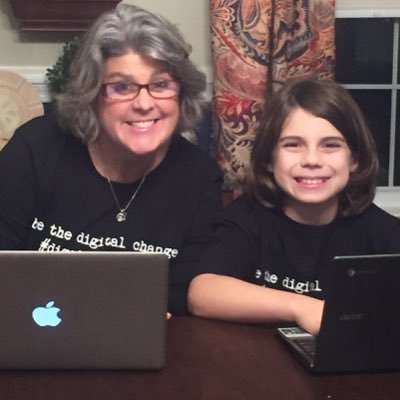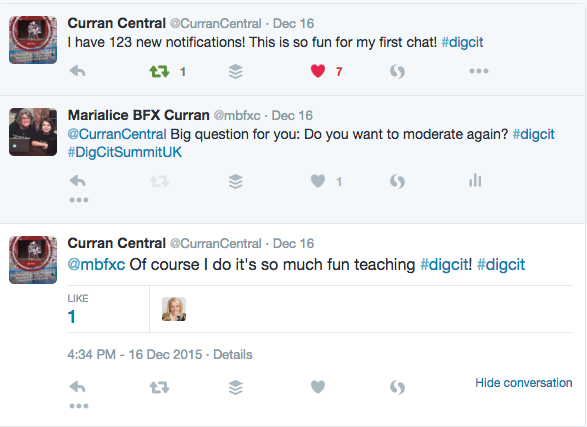As an educator at both the K-12 and college level, I have been trying to find a variety of ways to instill digital citizenship in students. In November 2013, I wanted to create a teachable moment for my undergraduate students on the permanency of their decisions made online, as well as the consequences of an unintended audience. What I soon realized was that my role as an educator and as a parent would coincide.
When thinking about the permanency of our decisions and the virality of our post, my mind instantly thought of Jules Verne. If Jules Verne could travel around the world in 80 days, what about a tweet? How quickly could a single tweet be retweeted around the world, and where would it travel to? The resulting project was a Tweet Seen Around the World , which would travel to all 50 states, read in 30 countries and six out of the seven continents (come on, Antarctica) in 24 hours. As the 264 responses were pinging, my son, a first grader at the time, was mesmerized. I would announce, “We made it to Indonesia,’ and he’d echo with such excitement in his voice, “We made it to Indonesia! Where’s Indonesia?”
The teachable moment for my students just became an invaluable geography and tech lesson for my son. Life as a parent is filled with teachable moments for for digital citizenship. Here are four ways to capture a teachable moment and model good digital citizenship:
1. Embrace Your Child’s Tangents
By embracing my son’s imagination, I let him take a lead in how the project would develop. We took out a world map and started finding all the locations. My son also started to tally the responses. He was so engaged in the learning process that the geography lesson became something so much more -- he had his first glimpse at being a connected learner.
2. Find Useful Digital Tools
There are an incredible amount of digital tools, most of them free, that are available to parents looking to create a teachable moment with their child. For my son, it was a blog that he thought would work best.
When I asked him why he needed his own blog, he responded, “I want to keep learning about the world.” We started his blog 48 hours after the tweet was seen around the world. In fact, as a first grader he was a guest blogger for Angela Maiers, "Around the World With Curran".
The most exciting blog post happened when he was studying about animals in the rainforest. He came home with the packet of directions and said that he didn’t want to learn about the animals on the list. He asked if he could blog about it and if I would tweet out his blog post. Amazing that a first grader could understand the power of social media as a learning tool. He blogged, "Animals in the Rainforest" and asked the readers to make suggestions on which rainforest animal they would want to research. Just like finding all the locations on the world map, my son researched every animal that was mentioned. He must have researched at least 20 rainforest animals. He put them into lists and finally he had his top 10, then his top 5, then his number one animal for the project: the binturong. How would we have ever know about the binturong without the opportunity to learn through social media tools? As a mother, I was happy that he was so involved in this project, but as an educator my heart broke because every student should have the same opportunities to learn.

Unfortunately, my son's elementary school is a traditional school. He does not have access to learning with the world at his school. He only has access at home with a mother learning side-by- side with him. Therefore, digital access is a topic that is vital for all students everywhere to be able to think and act at a local, global, and digital level simultaneously.
3. Feed the Passion
Since 2013, we have continued to learn together on the importance of being SAFE, SAVVY, and ETHICAL both on and offline. In October at our inaugural Digital Citizenship Summit, my son got on stage with me for the closing remarks and he shared his story above.
Within the past month, now a third grader, he has been actively involved with the planning of the first international Digital Citizenship Summit at Bournemouth University being held on January 23, 2016. Each day before getting on and off the school bus, he has wanted to check the #DigCitSummitUK Twitter feed and asked if he could get his own Twitter account. I explained to him that his mom plays by the rules and that Twitter users must be 13 years or older. Disappointed by the response, he asked if we could set up a mother and son account.
4. Find Additional Outlets
Similar to how he began to blog, we are using Twitter as a learning tool to model student voice in digital citizenship. As the co-founder of the #digcit chat on Twitter in 2011, my son has seen me moderate Twitter chats at home, but a few weeks ago, I had the pleasure of co-moderating the chat with him. We planned the questions, timed our tweets and sat side by side during the chat. These tweets sum up the entire experience:

I would like to echo my son’s tweet, “Of course I do it’s so much fun teaching #digcit!” I’d like to add to this statement that the fun part is learning together. By embracing his tangent, finding a digital tool, feeding his passion, and finding additional outlets, I was able to capture the teachable moment and model good digital citizenship.
Now it’s your turn.
Photos courtesy of Marialice B.F.X. Curran, Ph.D.
Written by
Marialice B.F.X Curran, Ph.D.
Co-founder Digital Citizenship Summit, digital citizenship (#digcit) chat co-founder and moderator on Twitter and K-4 Media Specialist, Wakefield Public Schools in Massachusetts. Focused on helping students think and act at a local, global and digital level simultaneously.
















.svg)

